Roombas on Hardwood? (3 Performance Tips!)
It’s not just about slapping down planks; it’s about selecting the right wood, carefully crafting the finish, and paying attention to every little detail. Think of it like building a fine piece of furniture – each step contributes to the final masterpiece.
We’re talking oak, maple, cherry – each with its unique grain patterns and color variations. I’ve spent countless hours matching grain, staining, and applying protective finishes to bring out the natural beauty of the wood.
A good finish doesn’t just look pretty; it protects against scratches, moisture, and everyday life. And let me tell you, life happens on those floors!
But what happens when you introduce a robot vacuum into the mix? Can a Roomba, designed for convenience, truly coexist with the elegance of a well-crafted hardwood floor?
That’s what we’re going to explore today. I’ll share my expert tips to help you keep your hardwood pristine while making the most of your robotic helper.
Section 1: Understanding Roombas and Their Technology
So, what exactly is a Roomba? It’s a robotic vacuum cleaner, designed to autonomously navigate your home and suck up dirt, dust, and debris.
Over the years, Roombas have evolved from simple bump-and-go devices to sophisticated cleaning machines with advanced sensors and mapping technology.
I remember when the first Roombas came out. They were pretty basic, just bouncing around and hoping for the best. Now, we have models with cameras, laser sensors, and even self-emptying capabilities.
The models best suited for hardwood floors typically have soft brushes and adjustable suction levels to avoid scratching the surface. Think of the iRobot Roomba i7+ or the Roomba s9+; they’re popular choices for delicate surfaces.
These newer models use sophisticated sensors to map your home, allowing them to clean efficiently and avoid obstacles. They can even learn your floor plan and adapt their cleaning patterns.
For example, the Roomba j7+ uses “PrecisionVision Navigation” to recognize and avoid obstacles like cords and pet waste. Pretty cool, huh?
Understanding how these little guys work is crucial for maximizing their performance on your beautiful hardwood floors. It’s not just about setting it and forgetting it; it’s about understanding the tech and using it to your advantage.
Section 2: Performance Tip #1 – Regular Maintenance of Your Roomba
Alright, let’s dive into the first performance tip: regular Roomba maintenance. Think of your Roomba like a car; it needs regular tune-ups to run smoothly.
Keeping your Roomba in top shape is essential for effective cleaning, especially on hardwood floors. A neglected Roomba is like trying to cut wood with a dull saw – frustrating and ineffective.
Here’s what you need to do:
-
Clean the brushes: Hair and debris buildup on the brushes can significantly reduce cleaning performance. I recommend cleaning the brushes at least once a week, or more often if you have pets.
-
Remove the brushes and use a cleaning tool (usually included with the Roomba) to remove any tangled hair or debris.
-
You might be surprised at how much gunk accumulates!
-
Empty the dustbin: A full dustbin reduces suction power, which means your Roomba won’t be able to pick up as much dirt and dust. Empty the dustbin after each cleaning session, or at least every other session.
-
Some newer models, like the Roomba i7+ and s9+, have self-emptying bases, which makes this task much easier.
-
Check and replace filters: The filter traps dust and allergens, preventing them from being released back into the air. A clogged filter reduces suction and can even damage the motor.
-
Check the filter every month and replace it every few months, depending on usage.
-
I usually recommend replacing the filter every 2-3 months for optimal performance.
-
Let me give you a real-world example. I had a client who complained that their Roomba wasn’t cleaning their hardwood floors effectively. After a quick inspection, I discovered that the brushes were completely clogged with hair, and the filter was black with dust.
After cleaning the brushes and replacing the filter, the Roomba was back to its old self, leaving their hardwood floors sparkling clean.
Regular maintenance not only enhances cleaning efficiency but also prolongs the lifespan of your Roomba. It’s a win-win situation.
Section 3: Performance Tip #2 – Optimize Cleaning Modes for Hardwood
Now, let’s talk about cleaning modes. Roombas offer various cleaning modes, and choosing the right one can make a big difference on hardwood floors.
Think of it like choosing the right tool for the job. You wouldn’t use a sledgehammer to hang a picture, right? Similarly, you need to select the appropriate cleaning mode for your hardwood floors.
Here’s a breakdown of some common cleaning modes and how they work on hardwood:
- Automatic Mode: This is the default mode, where the Roomba cleans the entire floor area. It’s suitable for general cleaning but may not be the most efficient for specific messes.
- Spot Clean Mode: This mode focuses on a small area, providing concentrated cleaning for spills or messes. It’s perfect for quickly cleaning up a dropped bowl of cereal or a pet accident.
- Edge Clean Mode: This mode directs the Roomba to clean along the edges of walls and furniture, where dust and debris tend to accumulate. It’s great for getting into those hard-to-reach areas.
- Scheduled Cleaning Mode: This mode allows you to schedule cleaning sessions in advance, so your Roomba can clean while you’re away. It’s ideal for routine maintenance and keeping your hardwood floors consistently clean.
For hardwood floors, I recommend using a combination of these modes. Use the automatic mode for general cleaning, the spot clean mode for specific messes, and the edge clean mode to target those edges.
The frequency of cleaning sessions depends on your household traffic and dust accumulation. If you have pets or young children, you may need to clean more frequently.
I generally recommend cleaning hardwood floors with a Roomba at least 2-3 times per week. This helps to prevent dust and dirt from building up and scratching the surface.
One of my clients, a busy mom with two kids and a dog, schedules her Roomba to clean every morning while she’s at work. This keeps her hardwood floors consistently clean and saves her time and effort.
Remember, the key is to experiment with different cleaning modes and find what works best for your specific needs and your hardwood floors.
Section 4: Performance Tip #3 – Setting Up Your Space for Success
Alright, let’s talk about setting up your space for Roomba success. The configuration of your furniture and obstacles can significantly impact Roomba performance on hardwood floors.
Think of it like creating a race track for your Roomba. The fewer obstacles, the smoother the ride, and the more efficient the cleaning.
Here’s some practical advice on arranging furniture to facilitate smoother navigation for your Roomba:
-
Minimize clutter: Clutter is the enemy of a Roomba. The more clutter you have on the floor, the more likely the Roomba is to get stuck or miss spots.
- Pick up loose items like shoes, toys, and cords before running the Roomba.
-
Ensure clear pathways: Make sure there are clear pathways for the Roomba to navigate. Avoid placing furniture too close together, as this can create narrow passages that the Roomba can’t fit through.
-
Leave enough space between furniture for the Roomba to turn around and maneuver.
-
Use virtual barriers or no-go zones: Virtual barriers and no-go zones are a great way to keep the Roomba out of areas that require special attention or protection.
-
Use virtual barriers to prevent the Roomba from entering areas with delicate rugs or fragile furniture.
-
Use no-go zones to keep the Roomba away from pet bowls or areas where you don’t want it to clean.
I had a client with a beautiful antique rug that she didn’t want the Roomba to clean. We used a virtual barrier to create a no-go zone around the rug, ensuring that the Roomba only cleaned the surrounding hardwood floors.
Preparing your environment is crucial for maximizing cleaning efficiency and reducing the chances of the Roomba getting stuck or missing spots.
It’s like preparing a canvas before painting. The smoother the surface, the better the final result.
By minimizing clutter, ensuring clear pathways, and using virtual barriers, you can create a Roomba-friendly environment that allows it to clean your hardwood floors effectively and efficiently.
Conclusion: The Perfect Harmony of Technology and Craftsmanship
So, there you have it – my expert tips for using Roombas on hardwood floors. It’s all about finding the perfect harmony between technology and craftsmanship.
Hardwood floors are a testament to skilled artistry and attention to detail. They add beauty, warmth, and value to your home.
But maintaining their beauty and integrity requires thoughtful integration of modern cleaning technology. Roombas can be a valuable tool for keeping your hardwood floors clean and well-maintained, but only if used correctly.
By following my performance tips, you can ensure that your Roomba works in harmony with your hardwood floors, keeping them pristine and beautiful for years to come.
Remember, it’s not about replacing traditional cleaning methods entirely. It’s about complementing them with technology to make your life easier and your home cleaner.
Embrace the synergy of both worlds – the timeless elegance of hardwood flooring and the modern convenience of robotic cleaning.
With a little knowledge and effort, you can achieve pristine, well-maintained hardwood floors that will be the envy of your neighbors.
So go ahead, unleash your Roomba and enjoy the beauty of your hardwood floors. You deserve it!





